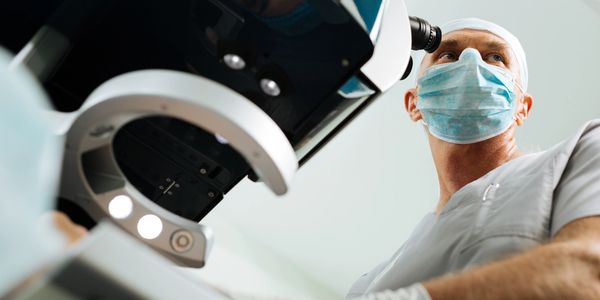Specialized Skills
Robot-Assisted Thoracoscopic Surgery
Robot-Assisted Thoracoscopic Surgery
Robot-Assisted Thoracoscopic Surgery

Robot-assisted thoracic surgery offers several benefits over traditional open surgery. It involves small incisions, minimizing trauma to surrounding tissues and reducing pain. Surgeons control robotic instruments with precision, allowing delicate maneuvers during lung tissue removal. Enhanced visualization through high-definition 3D cameras ensures accuracy. Patients experience less blood loss, shorter hospital stays, quicker return to normal activities, and minimal scarring.
Lung Volume Reduction
Robot-Assisted Thoracoscopic Surgery
Robot-Assisted Thoracoscopic Surgery

Endobronchial and surgical lung volume reduction (LVR) offer valuable options for managing severe emphysema. Endobronchial valve placement allows trapped air to escape from diseased lung regions, reducing the size of affected lobes. Lung volume reduction surgery (LVRS) removes most emphysematous parts of the lung, allowing restoration of respiratory mechanics. Both approaches enhance lung function, alleviate symptoms, and contribute to well-being.
Management of airway disease
Correction of chest wall deformities
Correction of chest wall deformities

Rigid and Flexible bronchoscopy techniques allow direct visualization of the airways, enabling accurate assessment and initial diagnosis. Examples of bronchoscopic interventions include stenting to reopen blocked airways, laser therapy or cryotherapy for management of endobronchial lesions, electrocautery to remove tissue, balloon dilatation for airway stenosis and endobronchial valves for emphysema. These targeted treatments enhance patient outcomes and respiratory health.
Correction of chest wall deformities
Correction of chest wall deformities
Correction of chest wall deformities

Thoracic surgery can effectively manage pectus deformities, which affect the anterior thorax. The Nuss Procedure allows a minimally invasive repair for pectus excavatum and offers benefits such as reduced postoperative pain, shorter hospital stays, and faster recovery. The more invasive Ravitch Procedure is a form of open surgery used for both pectus excavatum and pectus carinatum deformities and can improve chest wall appearance and pulmonary function. Customizable treatments ensure better outcomes.
Practice Areas
Lung cancer
Lung cancer
Lung cancer
Lung resections for lung or metastatic cancer involve removing cancerous parts of the lung and can be performed using different approaches: Robotic-Assisted Thoracoscopic Surgery (RATS), Video-Assisted Thoracoscopic Surgery (VATS), Posterolateral Thoracotomy.
Mediastinum
Lung cancer
Lung cancer
Surgical management of mediastinal masses involves thoracoscopic surgery or sternotomy; choice depends on tumor size and location. Thymectomy, the surgical removal of the thymus gland, is performed to treat conditions like myasthenia gravis and thymoma.
Diaphragm
Lung cancer
Diaphragm
Surgical diaphragmatic plication treats diaphragmatic paralysis and involves open or thoracoscopic surgery with small incisions. The diaphragm is depressed into the abdomen, and sutured to stay in a contracted position, creating space in the chest for better inhalation.
Airway
Hyperhidrosis
Diaphragm
Management options include Cryotherapy (uses cold to treat airway disease), Laser therapy (cuts and coagulates), Stents (for large airway diseases), Balloon dilation (for airway strictures) and Endobronchial biopsy (tissue sampling) via conventional or navigation bronchoscopy.
Chest wall
Hyperhidrosis
Hyperhidrosis
Pectus excavatum correction via the Nuss procedure, a minimally invasive technique which involves insertion of a bar. Rib fixation may involve rib stabilization using plates and screws. Slipped Rib Syndrome is managed by cartilage excision, rib resection, and rib stabilization.
Hyperhidrosis
Hyperhidrosis
Hyperhidrosis
The most effective surgical treatment is endoscopic thoracic sympathectomy. The procedure is typically used for severe cases that have not responded to nonsurgical treatments and involves cutting the sympathetic nerves, which control sweating, at a precise location.
Pneumothorax
Pleural Effusion
Pleural Effusion
Surgical management via minimally invasive bullectomy and pleurodesis, a procedure performed to prevent recurrence by introducing a chemical, usually talc, into the pleural space, or by abrading or removing the inner lining of the chest wall.
Pleural Effusion
Pleural Effusion
Pleural Effusion
Management involves pleurodesis (obliteration of pleural space) or insertion of an Indwelling Pleural Catheter (a tube inserted into the pleural cavity to routinely drain accumulated fluid), and depends on the patient’s condition and the underlying cause of the effusion.
Empyema
Pleural Effusion
Empyema
Drainage is used for stages 1 and 2. For stage 3, surgical intervention is necessary and procedures include decortication (removal of the thick layer of pus and fibrin covering the lung), thoracoplasty, window procedure (Eloesser flap), and rib resection.
Dr Periklis Perikleous, Consultant in Thoracic Surgery at St George's University Hospitals NHS Foundation Trust in London, United Kingdom
With practicing privileges at Spire St Anthony's Hospital in London, United Kingdom
Copyright © 2024 drperiklisperikleous.co.uk